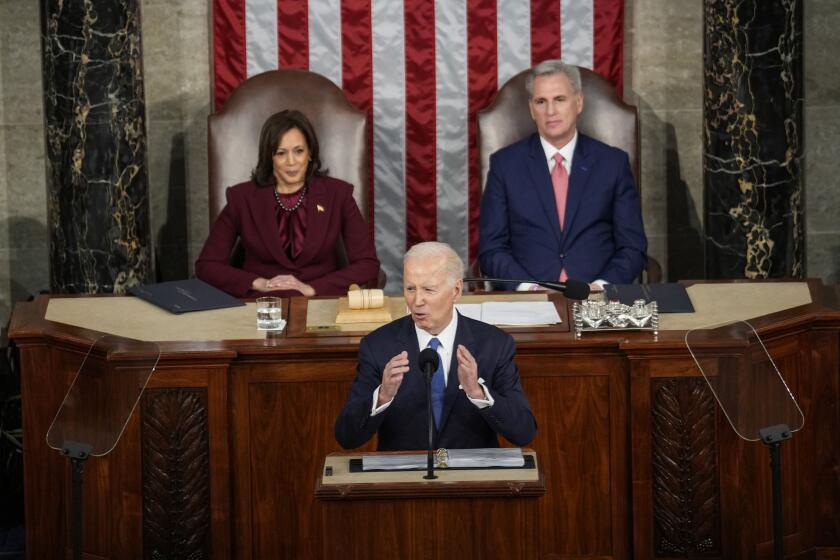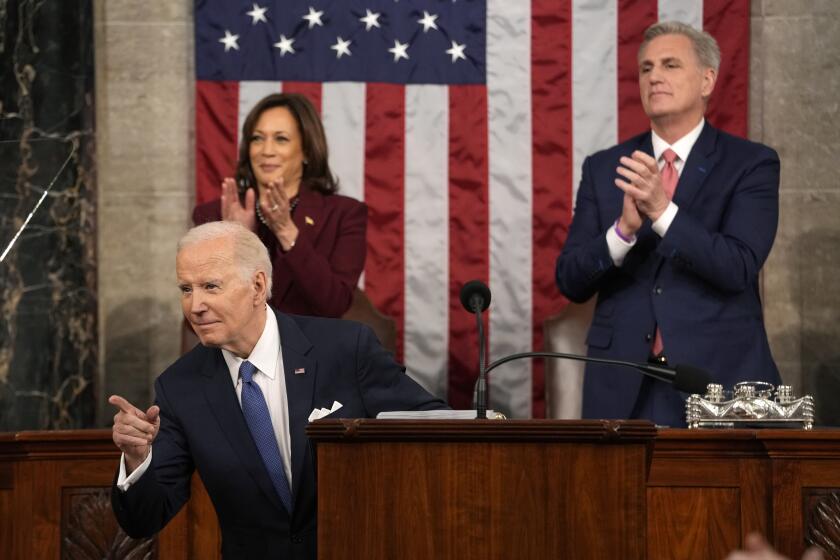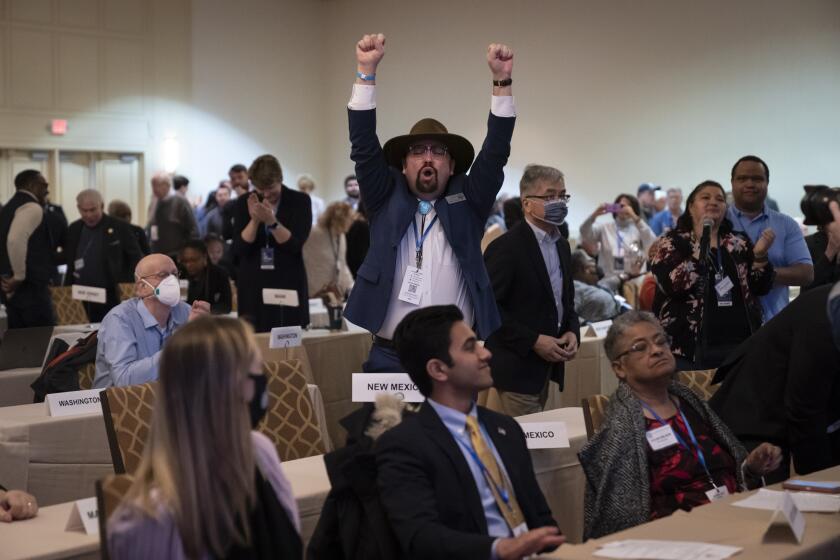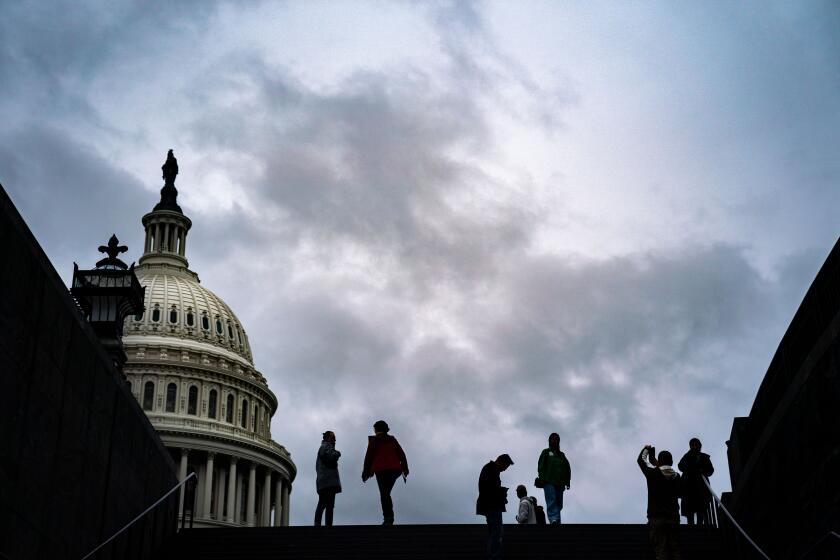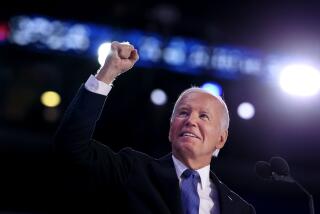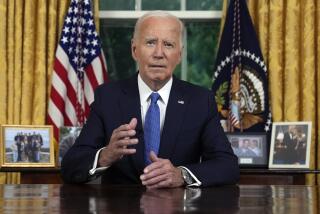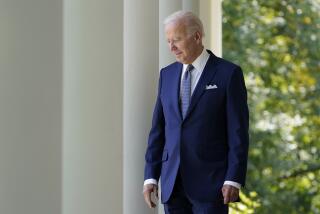Analysis: Why Bidenâs big speech may boost his reelection prospects
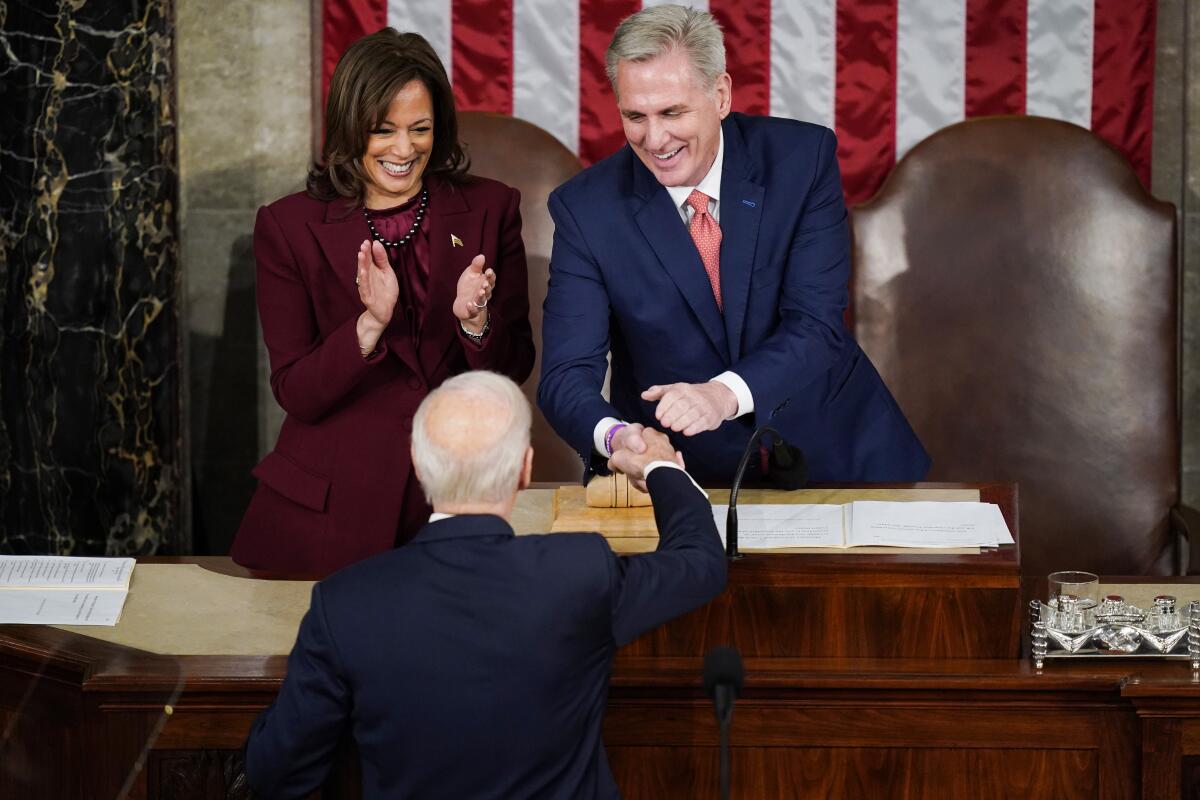
WASHINGTON â President Biden faces three big problems heading into a reelection campaign heâs expected to announce soon. His State of the Union speech aimed to help on two â and judging from early reaction, he may have succeeded.
Problem one: Even in his own party, a significant number of voters donât believe Biden has accomplished very much.
Second, across the board, voters worry about the health and stamina of the 80-year-old president, the oldest to hold the office.
A third problem has no achievable solution: In todayâs highly partisan times, nearly half of the country wonât favor the incumbent almost regardless of what he does. Over the last six presidential elections, only one â President Obamaâs reelection in 2012 â featured a popular vote margin greater than 5%; another close contest in 2024 seems all but inevitable.
Winning in that environment doesnât allow much margin for error. A president needs to hold the support of the vast majority of his own party and win over the relatively small but crucial share of voters who swing back and forth between the two sides.
One big speech canât negate all of his challenges, but it can open the way, especially among members of the presidentâs Democratic Party. And those who watched Tuesday night â as well as the larger audience that will see snippets in the days to come â saw an event that went off without a major hitch.
President Biden will try to convince Americans that the state of the union is strong as he eyes a 2024 reelection campaign.
Biden, who has struggled with stuttering since childhood, stumbled occasionally, as he always has. But he commanded the podium for well over an hour, parrying occasional heckling from Republicans such as Georgiaâs Rep. Marjorie Taylor Greene and offering a list of nonpartisan proposals â fighting cancer, cracking down on so-called junk fees, helping veterans â that at times elicited nods of support from House Speaker Kevin McCarthy (R-Bakersfield), sitting behind him.
With at least a dozen calls for bipartisanship, which bracketed two direct veto threats â one against any abortion ban, the other against efforts to repeal last yearâs Inflation Reduction Act â Biden sought to present himself as the mature adult keeping watch over an unruly Congress.
Those moments, especially the threat to veto an abortion ban, drew strongly positive responses from a panel of about 30 independent and nonpartisan voters convened in Las Vegas by Navigator Research, a Democratic firm.
The group showed âclear movement in favor of the president,â said Democratic pollster Margie Omero. Compared with the ratings that members of the group gave before the speech, âviews of the president himself, his favorability, jumped about 20 points,â she said.
In a State of the Union address that began as a bipartisan appeal, President Biden appeared combative and feisty at times as he sparred with Republicans over his legislative record, the federal deficit and border security.
Itâs important not to overstate how much difference that can make â memories of any single speech fade quickly.
And the challenges Biden faces remain significant. Within his own party, voters have been tepid, at best, about the idea of a second term. In a recent poll for the Associated Press conducted by NORC at the University of Chicago, just 37% of Democrats said they wanted him to run again. Among independents, only 12% were in favor of Biden running.
But the reaction to his speech Tuesday does illustrate that despite the problems he faces, Biden continues to have the ability to unify his party and reach a significant slice of independent voters.
Thatâs one major reason Biden has a strong shot at winning a second term. He also benefits from the risk Republicans face â a divisive primary with former President Trump threatening not to support the party if someone else becomes its nominee.
The biggest potential upside for Biden, however, is the possibility of significant economic improvement over the 21 months between now and the next election. Inflation already has been on the decline for months, and last weekâs jobs report showed unemployment dropping to the lowest rate in more than 50 years.
âI would argue the Biden economic plan is working,â the president said after those numbers were released.
So far, votersâ view of the economy remains much more negative than the official statistics, but Democrats hope to turn around that skepticism.
âWeâve been though some really tough thingsâ over the last few years, Omero said, so âitâs understandable that people feel wary of any signs of recovery.â
This is what itâs like to be summoned to Washington as an official national hero â the presidentâs special guest at the State of the Union address â while you are still processing your own emotions.
If current trends continue, some of that skepticism will fade, Democrats hope.
To take full advantage of any good economic news, however, Biden needs to persuade voters that he has put policies in place that mattered. So far, he hasnât convinced them.
A recent Washington Post/ABC News poll illustrated the depth of that problem. Asked how much Biden had accomplished, 62% of respondents said he had achieved little or nothing, compared with 36% who said he had achieved a great deal or a good amount.
Republicans overwhelmingly fell into the negative camp, but even among Democrats, roughly 1 in 5 said he had achieved little or nothing. Among independents who lean Democratic, 30% took that view.
Under the new calendar, proposed based on recommendations from Biden, candidates would face voters in South Carolina on Feb. 3, followed by Nevada and New Hampshire.
Biden and his aides vehemently dispute that idea, reeling off a list of achievements at every opportunity â the bipartisan infrastructure bill that will pump $1.2 trillion into repairing roads, bridges and rail systems, upgrading water systems to eliminate lead pipes and make other improvements; efforts to combat climate change; legislation to lower the price of prescription drugs for Americans covered by Medicare; and healthcare measures that have made insurance cheaper for millions of middle-income Americans.
Administration officials argue, with considerable justification, that their victories have been drowned out by the din of partisan warfare in Washington and by media coverage that focuses on conflict more than results.
Itâs also true, however, that much of that new legislation has yet to have direct impact on Americansâ lives. The infrastructure law, for example, will play out over the next decade. The plan to reduce drug costs for seniors will start this year, with a $35 cap on the cost of insulin, but price reductions on a much wider range of drugs wonât start phasing in until 2026.
Biden conceded that point in a line in his speech that was not in his prepared text, saying that âso many things that we did are just now coming to fruition.â
Californiaâs 2024 Senate race has sent ripples down-ballot, as ambitious politicians eye soon-to-be vacant House seats in Los Angeles, Orange County and possibly the Bay Area.
Emphasizing his accomplishments has been a major preoccupation for Biden ever since the midterm campaign ended, with events like a trip to Baltimore late last month to tout funding to rebuild a critical railroad tunnel that dates to the Ulysses S. Grant administration, and another earlier in the month in Kentucky, where he and Senate Republican leader Mitch McConnell heralded plans to build a new bridge across the Ohio River.
That same list of victories formed most of the first half of Tuesdayâs speech, underscoring how crucial it is for Biden to convince Americans that he has achieved victories.
Doing so is important to boost enthusiasm among Democrats, who want to see movement toward progressive goals, and to win over independents, who dislike partisan bickering.
Itâs also critical to convincing Americans of one of the central claims of Bidenâs presidency, said veteran Democratic strategist Steve Schale, a former Biden campaign advisor: âThat there is a way to govern in this almost ungovernable moment.â
More to Read
Get the L.A. Times Politics newsletter
Deeply reported insights into legislation, politics and policy from Sacramento, Washington and beyond. In your inbox three times per week.
You may occasionally receive promotional content from the Los Angeles Times.
